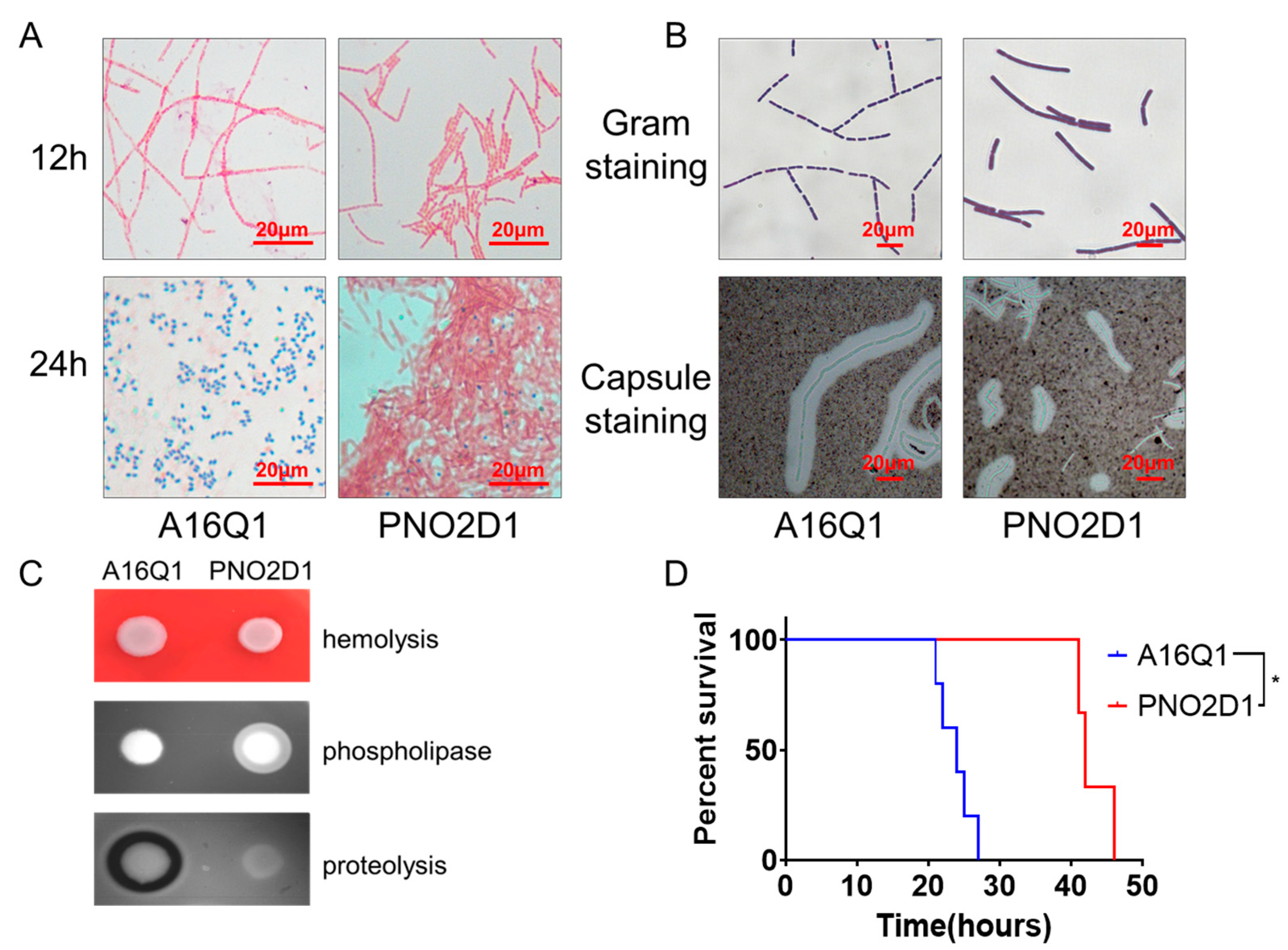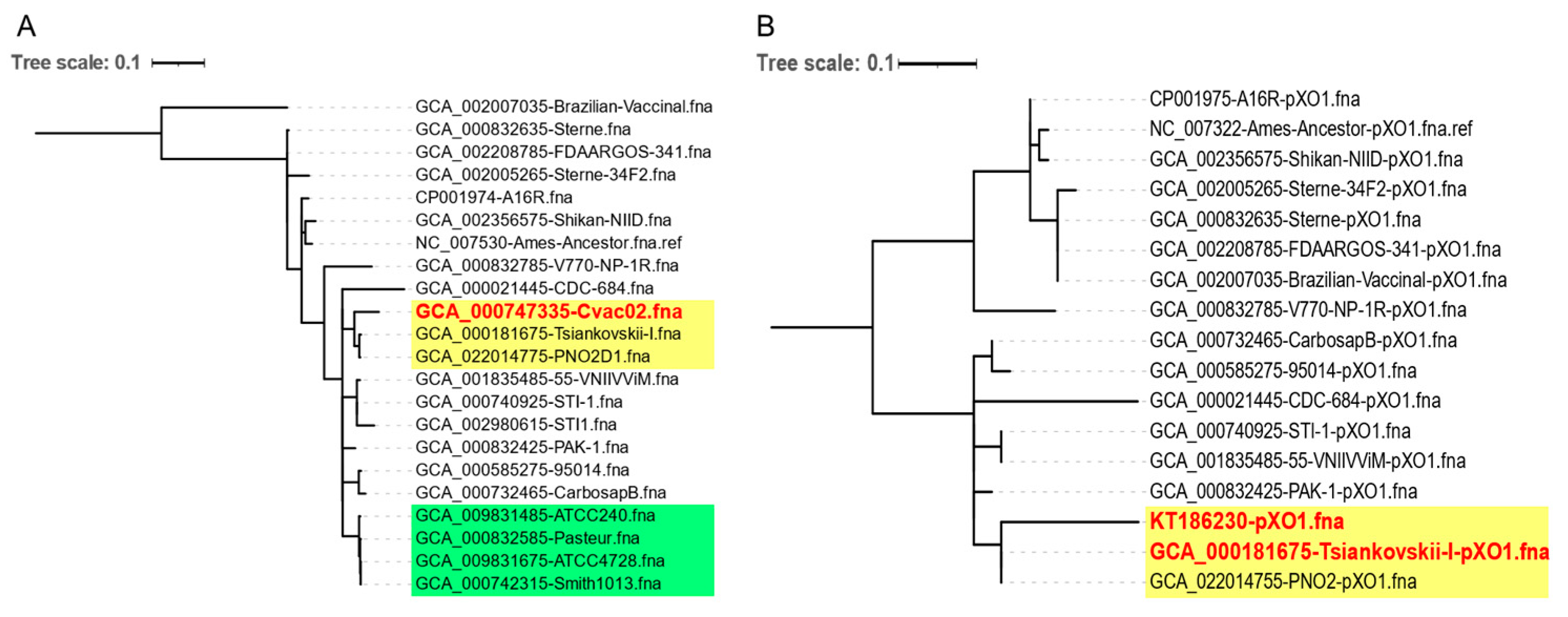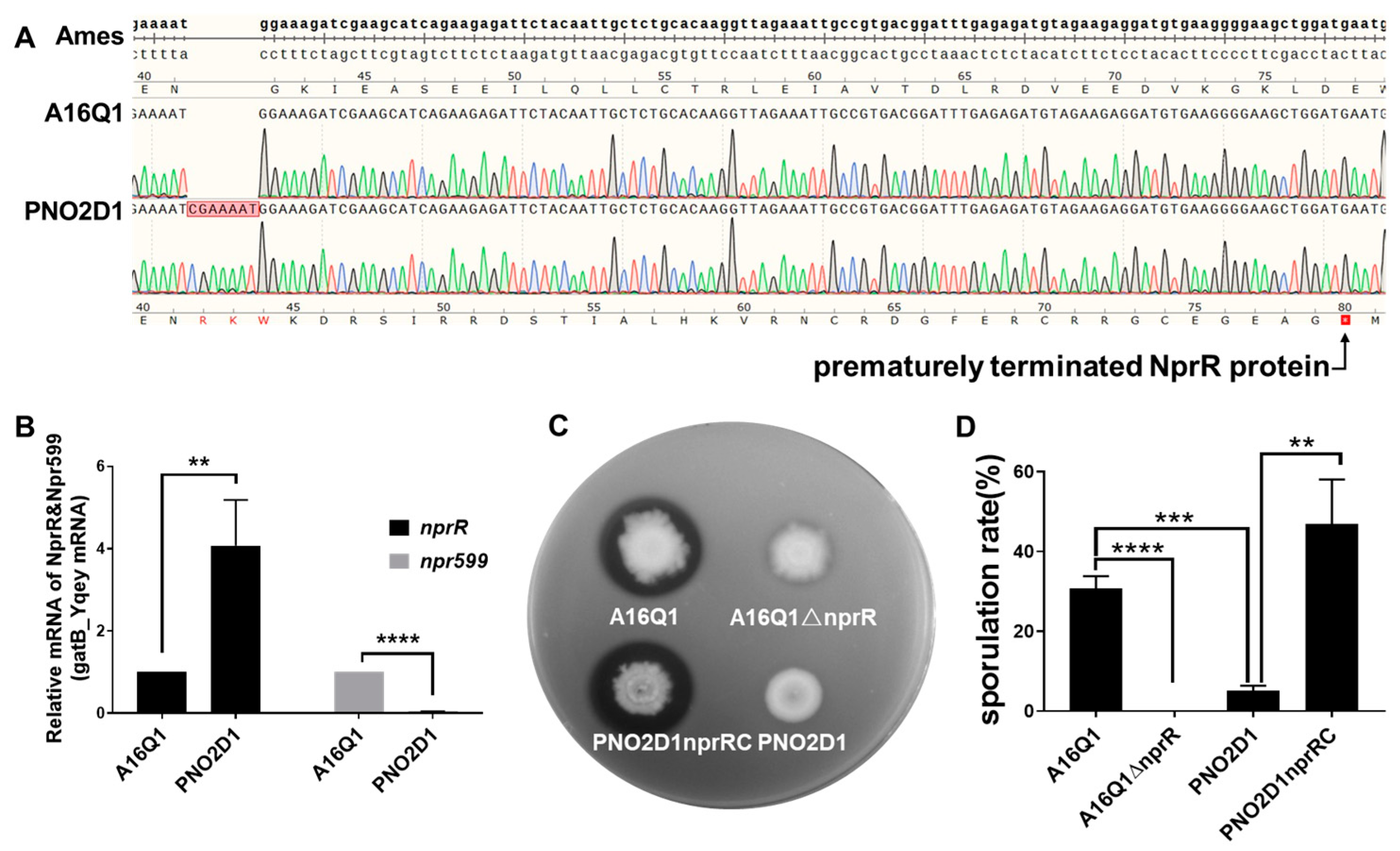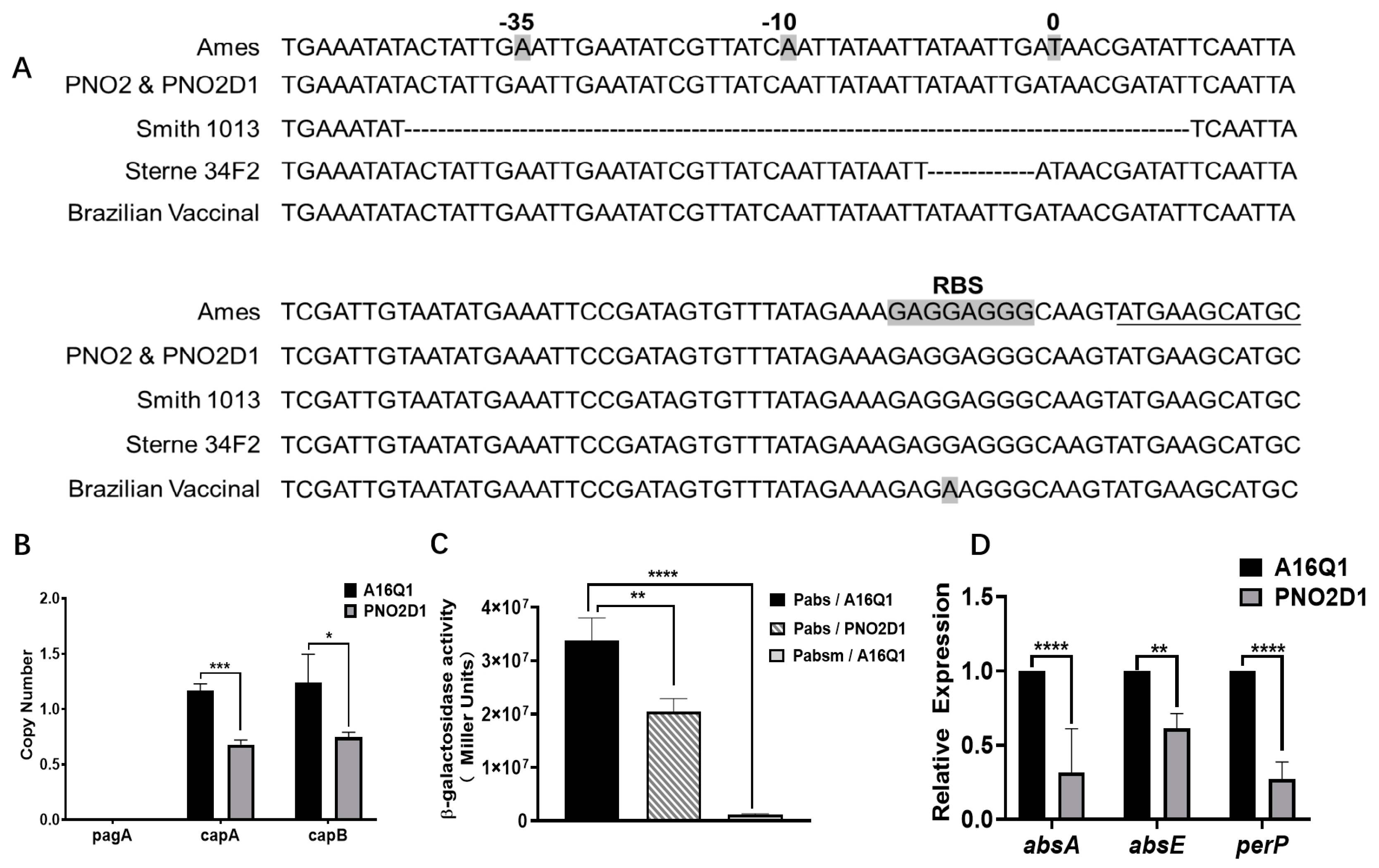Genome Sequence and Phenotypic Analysis of a Protein Lysis-Negative, Attenuated Anthrax Vaccine Strain
Abstract
:Simple Summary
Abstract
1. Introduction
2. Materials and Methods
2.1. Strains and Plasmids
| Plasmid or Strain | Genotype or Description | Source |
|---|---|---|
| Plasmid | ||
| pBE2 | Shuttle vector, Kanr in B. anthracis and Ampr in E. coli | [21] |
| pBE2nprR | pBE2A carrying nprR gene, nprR complementation plasmid, Ampr in E. coli, Kanr in B. anthracis | This study |
| pHT304 | Shuttle vectors, Ermr, Ampr | [26] |
| pHT304-lacZ | Promoterless lacZ vector, Ermr, Ampr, 9.7 kb | [27,28] |
| pHT304-Pabs | pHT304-lacZ carrying Promoter Pabs, Ampr in E. coli, Ermr in B. anthracis | This study |
| pHT304-Pabsm | pHT304-lacZ carrying mutant promoter Pabsm, Ampr in E. coli, Ermr in B. anthracis | This study |
| E. coli | ||
| DH5α | F2, Q80d/lacZDM15, D(lacZYA-argF)U169, deoR, recA1, endA1, hsdR17(rk 2,mk+), phoA, supE44l2, thi-1, gyrA96, relA1 | Transgen, Beijing, China |
| JM110 | rpsL(StrR), thr, leu, endA, thi-1, lacy, galK, galT, ara, tonA, tsx, dam−, dcm−, supE44(lac-proAB), F- [traD36, proAB, lacIqlacZΔM15] | Transgen, Beijing, China |
| B. anthracis strain | ||
| A16Q1 | Nontoxigenic encapsulated strain; pXO1−, pXO2+ | [20] |
| A16Q1ΔnprR | A16Q1 nprR deletion mutant | This study |
| PNO2 | Putative No.II Vaccine strain; pXO1+, pXO2+ | [10] |
| PNO2D1 | PNO2 strain cured pXO1; pXO1−, pXO2+ | This study |
| PNO2D1nprRc | nprR complementation strain containing pBE2nprR plasmid; Kanr | This study |
| Pabs/PNO2D1 | PNO2D1 strain containing plasmid pHT304-Pabs, Ermr in B. anthracis | This study |
| Pabs/A16Q1 | A16Q1 strain containing plasmid pHT304-Pabs, Ermr in B. anthracis | This study |
| Pabsm/A16Q1 | A16Q1 strain containing plasmid pHT304-Pabsm, Ermr in B. anthracis | This study |
2.2. Phenotypic Characterization
2.3. Genome Sequencing
2.4. Virulence Testing
2.5. Quantitative Reverse-Transcription PCR
2.6. β-Galactosidase Assays
3. Results
3.1. Phenotypic Characteristics of PNO2D1
3.2. Whole-Genome Sequencing of PNO2 and PNO2D1
3.3. nprR Mutation Resulted in a Nonproteolytic Phenotype and Decreased Sporulation of PNO2D1
3.4. abs Gene Cluster Expression May Be Associated with PNO2D1 Attenuation
4. Discussion
5. Conclusions
Author Contributions
Funding
Institutional Review Board Statement
Informed Consent Statement
Data Availability Statement
Acknowledgments
Conflicts of Interest
References
- Mock, M.; Fouet, A. Anthrax. Annu. Rev. Microbiol. 2001, 55, 647–671. [Google Scholar] [CrossRef] [PubMed]
- Mikesell, P.; Ivins, B.E.; Ristroph, J.D.; Dreier, T.M. Evidence for plasmid-mediated toxin production in Bacillus anthracis. Infect. Immun. 1983, 39, 371–376. [Google Scholar] [CrossRef] [PubMed]
- Green, B.D.; Battisti, L.; Koehler, T.M.; Thorne, C.B.; Ivins, B.E. Demonstration of a capsule plasmid in Bacillus anthracis. Infect. Immun. 1985, 49, 291–297. [Google Scholar] [CrossRef]
- Cote, C.K.; Rooijen, N.V.; Welkos, S.L. Roles of Macrophages and Neutrophils in the Early Host Response to Bacillus anthracis Spores in a Mouse Model of Infection. Infect. Immun. 2006, 74, 469–480. [Google Scholar] [CrossRef] [PubMed]
- Scorpio, A.; Blank, T.E.; Day, W.A.; Chabot, D.J. Anthrax vaccines: Pasteur to the present. Cell. Mol. Life Sci. 2006, 63, 2237–2248. [Google Scholar] [CrossRef]
- Thorkildson, P.; Kinney, H.L.; AuCoin, D.P. Pasteur revisited: An unexpected finding in Bacillus anthracis vaccine strains. Virulence 2016, 7, 506–507. [Google Scholar] [CrossRef] [PubMed]
- Uchida, I.; Hashimoto, K.; Terakado, N. Virulence and Immunogenicity in Experimental Animals of Bacillus anthracis Strains Harbouring or Lacking 110 MDa and 60 MDa Plasmids. J. Gen. Microbiol. 1986, 132, 557–559. [Google Scholar] [CrossRef]
- Ivins, B.E.; Ezzell, J.; Jemski, J.; Hedlund, K.W.; Leppla, S.H. Immunization studies with attenuated strains of Bacillus anthracis. Infect. Immun. 1986, 52, 454–458. [Google Scholar] [CrossRef]
- Friedlander, A.M.; Welkos, S.L.; Ivins, B.E. Anthrax Vaccines. Curr. Top. Microbiol. Immunol. 2002, 271, 33–60. [Google Scholar]
- Liang, X.; Zhang, H.; Zhang, E.; Wei, J.; Jin, Z. Identification of the pXO1 plasmid in attenuated Bacillus anthracis vaccine strains. Virulence 2016, 7, 578–586. [Google Scholar] [CrossRef]
- Welkos, S.L. Plasmid-associated virulence factors of non-toxigenic (pX01−) Bacillus anthracis. Microb. Pathog. 1991, 10, 183. [Google Scholar] [CrossRef] [PubMed]
- Makino, S.; Watarai, M.; Cheun, H.; Shirahata, T.; Uchida, I. Effect of the Lower Molecular Capsule Released from the Cell Surface of Bacillus anthracis on the Pathogenesis of Anthrax. J. Infect. Dis. 2002, 186, 227–233. [Google Scholar] [CrossRef] [PubMed]
- Tang, H.M.; Liu, X.K.; Gao, M.Q.; Feng, E.L.; Zhu, L.; Shi, Z.X.; Liao, X.R. Construction of Putative S-Layer Protein SLP Deletion Mutant in Bacillus anthracis. Lett. Biotechnol. 2009, 20, 5. [Google Scholar]
- Welkos, S.L.; Vietri, N.J.; Gibbs, P.H. Non-toxigenic derivatives of the Ames strain of Bacillus anthracis are fully virulent for mice: Role of plasmid pX02 and chromosome in strain-dependent virulence. Microb. Pathog. 1993, 14, 381–388. [Google Scholar] [CrossRef] [PubMed]
- Pomerantsev, A.P.; Staritsin, N.A.; Mockov Yu, V.; Marinin, L.I. Expression of cereolysine AB genes in Bacillus anthracis vaccine strain ensures protection against experimental hemolytic anthrax infection. Vaccine 1997, 15, 1846–1850. [Google Scholar] [CrossRef] [PubMed]
- Liu, X.; Qi, X.; Zhu, L.; Wang, D.; Gao, Z.; Deng, H.; Wu, W.; Hu, T.; Chen, C.; Chen, W.; et al. Genome sequence of Bacillus anthracis attenuated vaccine strain A16R used for human in China. J. Biotechnol. 2015, 210, 15–16. [Google Scholar] [CrossRef] [PubMed]
- Cataldi, A.; Mock, M.; Bentancor, L. Characterization of Bacillus anthracis strains used for vaccination. J. Appl. Microbiol. 2000, 88, 648–654. [Google Scholar] [CrossRef]
- Adone, R.; Pasquali, P.; La Rosa, G.; Marianelli, C.; Muscillo, M.; Fasanella, A.; Francia, M.; Ciuchini, F. Sequence analysis of the genes encoding for the major virulence factors of Bacillus anthracis vaccine strain ‘Carbosap’. J. Appl. Microbiol. 2002, 93, 117–121. [Google Scholar] [CrossRef]
- Eremenko, E.; Pechkovskii, G.; Pisarenko, S.; Ryazanova, A.; Kovalev, D.; Semenova, O.; Aksenova, L.; Timchenko, L.; Golovinskaya, T.; Bobrisheva, O.; et al. Phylogenetics of Bacillus anthracis isolates from Russia and bordering countries. Infect. Genet. Evol. J. Mol. Epidemiol. Evol. Genet. Infect. Dis. 2021, 92, 104890. [Google Scholar] [CrossRef]
- Liu, X.; Wang, D.; Wang, H.; Feng, E.; Zhu, L.; Wang, H. Curing of Plasmid pXO1 from Bacillus anthracis Using Plasmid Incompatibility. PLoS ONE 2012, 7, e29875. [Google Scholar] [CrossRef]
- Wang, Y.; Jiang, N.; Wang, B.; Tao, H.; Zhang, X.; Guan, Q.; Liu, C. Integrated Transcriptomic and Proteomic Analyses Reveal the Role of NprR in Bacillus anthracis Extracellular Protease Expression Regulation and Oxidative Stress Responses. Front. Microbiol. 2020, 11, 590851. [Google Scholar] [CrossRef]
- Wang, Y.-c.; Yuan, L.-s.; Tao, H.-x.; Jiang, W.; Liu, C.-j. pheS* as a counter-selectable marker for marker-free genetic manipulations in Bacillus anthracis. J. Microbiol. Methods 2018, 151, 35–38. [Google Scholar] [CrossRef] [PubMed]
- Wang, X.; Lyu, Y.; Wang, S.; Zheng, Q.; Feng, E.; Zhu, L.; Pan, C.; Wang, S.; Wang, D.; Liu, X.; et al. Application of CRISPR/Cas9 System for Plasmid Elimination and Bacterial Killing of Bacillus cereus Group Strains. Front. Microbiol. 2021, 12, 536357. [Google Scholar] [CrossRef]
- Wang, Y.; Wang, D.; Wang, X.; Tao, H.; Feng, E.; Zhu, L.; Pan, C.; Wang, B.; Liu, C.; Liu, X.; et al. Highly Efficient Genome Engineering in Bacillus anthracis and Bacillus cereus Using the CRISPR/Cas9 System. Front. Microbiol. 2019, 10, 1932. [Google Scholar] [CrossRef] [PubMed]
- Altenbuchner, J. Editing of the Bacillus subtilis genome by the CRISPR-Cas9 system. Appl. Environ. Microbiol. 2011, 82, 5421–5427. [Google Scholar] [CrossRef] [PubMed]
- Agaisse, H.; Lereclus, D. Structural and functional analysis of the promoter region involved in full expression of the cryIIIA toxin gene of Bacillus thuringiensis. Mol. Microbiol. 1994, 13, 97–107. [Google Scholar] [CrossRef]
- Peng, Q.; Zhao, X.; Wen, J.; Huang, M.; Zhang, J.; Song, F. Transcription in the acetoin catabolic pathway is regulated by AcoR and CcpA in Bacillus thuringiensis. Microbiol. Res. 2020, 235, 126438. [Google Scholar] [CrossRef]
- Chen, M.; Lyu, Y.; Feng, E.; Zhu, L.; Pan, C.; Wang, D.; Liu, X.; Wang, H. SpoVG is Necessary for Sporulation in Bacillus anthracis. Microorganisms 2020, 8, 548. [Google Scholar] [CrossRef]
- Schilling, S.J. Studies on Anthrax Immunity: I. The Attentuation of Bacillus anthracis by means of Sodium Chloride and other Chemicals. J. Infect. Dis. 1926, 38, 341–353. [Google Scholar] [CrossRef]
- Yang, H.; Sikavi, C.; Tran, K.; McGillivray, S.M.; Nizet, V.; Yung, M.; Chang, A.; Miller, J.H. Papillation in Bacillus anthracis colonies: A tool for finding new mutators. Mol. Microbiol. 2011, 79, 1276–1293. [Google Scholar] [CrossRef]
- Wang, D.; Wang, B.; Zhu, L.; Wu, S.; Lyu, Y.; Feng, E.; Pan, C.; Jiao, L.; Cui, Y.; Liu, X.; et al. Genotyping and population diversity of Bacillus anthracis in China based on MLVA and canSNP analysis. Microbiol. Res. 2020, 233, 126414. [Google Scholar] [CrossRef]
- Chin, C.S.; Alexander, D.H.; Marks, P.; Klammer, A.A.; Korlach, J. Nonhybrid, finished microbial genome assemblies from long-read SMRT sequencing data. Nat. Methods 2013, 10, 563. [Google Scholar] [CrossRef]
- Koren, S.; Walenz, B.P.; Berlin, K.; Miller, J.R.; Bergman, N.H.; Phillippy, A.M. Canu: Scalable and accurate long-read assembly via adaptive k-mer weighting and repeat separation. Genome Res. 2017, 27, 722–736. [Google Scholar] [CrossRef] [PubMed]
- Li, W.; O’Neill, K.R.; Haft, D.H.; DiCuccio, M.; Chetvernin, V.; Badretdin, A.; Coulouris, G.; Chitsaz, F.; Derbyshire, M.K.; Durkin, A.S.; et al. RefSeq: Expanding the Prokaryotic Genome Annotation Pipeline reach with protein family model curation. Nucleic Acids Res. 2021, 49, D1020–D1028. [Google Scholar] [CrossRef] [PubMed]
- Treangen, T.J.; Ondov, B.D.; Koren, S.; Phillippy, A.M. The Harvest suite for rapid core-genome alignment and visualization of thousands of intraspecific microbial genomes. Genome Biol. 2014, 15, 524. [Google Scholar] [CrossRef]
- Tamura, K.; Stecher, G.; Kumar, S. MEGA11: Molecular Evolutionary Genetics Analysis Version 11. Mol. Biol. Evol. 2021, 38, 3022–3027. [Google Scholar] [CrossRef]
- Bland, J.M.; Altman, D.G. The logrank test. BMJ 2004, 328, 1073. [Google Scholar] [CrossRef] [PubMed]
- Reiter, L.; Kolstø, A.B.; Piehler, A.P. Reference genes for quantitative, reverse-transcription PCR in Bacillus cereus group strains throughout the bacterial life cycle. J. Microbiol. Methods 2011, 86, 210–217. [Google Scholar] [CrossRef]
- Miller, J.H. Experiments in Molecular Genetics; Cold Spring Harbor Laboratory: Cold Spring Harbor, NY, USA, 1972. [Google Scholar]
- Cendrowski, S.; MacArthur, W.; Hanna, P. Bacillus anthracis requires siderophore biosynthesis for growth in macrophages and mouse virulence. Mol. Microbiol. 2004, 51, 407–417. [Google Scholar] [CrossRef]
- Hagan, A.K.; Plotnick, Y.M.; Dingle, R.E.; Mendel, Z.I.; Hanna, P.C. Petrobactin Protects against Oxidative Stress and Enhances Sporulation Efficiency in Bacillus anthracis Sterne. mBio 2018, 9, e02079-18. [Google Scholar] [CrossRef]




| Primers | Sequence (5′–3′) | Note |
|---|---|---|
| q1981-F | AGGAAGTGGAGAATGGATTACAG | qPCR analysis for absA |
| q1981-R | GCCGATAACCGACAGCATA | |
| q1985-F | CGACAATGAACTGACTATGGA | qPCR analysis for absE |
| q1985-R | TTACTGCCGCTACAAGAC | |
| qPerR-F | GCAACTGTCTATAATAACTTAC | qPCR analysis for perR |
| qPerR-R | ATCAACAATCTTACCACATT | |
| qNprR-F | TTGTTCTGTCTCATACTTA | qPCR analysis for nprR |
| qNprR-R | TATATGCGTTCTACTTGT | |
| qNpr599-F | AGATGCTCACTACTATGC | qPCR analysis for npr599 |
| qNpr599-R | CAATTCCACCAGACAATG | |
| gatB_Yqey-F | AGCTGGTCGTGAAGACCTTG | reference |
| gatB_Yqey-R | CGGCATAACAGCAGTCATCA |
| GenBank Accession | BioSample | Assembly | Geographic Location | Strain | References | Mutation of nprR * | Mutation of abs * |
|---|---|---|---|---|---|---|---|
| GCA_001835485.1 | SAMN05915713 | ASM183548v1 | Georgia: Tbilisi | 55-VNIIVViM | PMID: 28007853 | 1064_1065insCTTAG | NA |
| GCA_002980615.3 | SAMN08627228 | ASM298061v3 | Russia: Saratov | STI1 | PMID: 9413092 | 1064_1065insCTTAG | NA |
| GCA_000740925.2 | SAMN02839456 | ASM74092v2 | Russia | STI-1(STI-89/K2789) | PMID: 25237016 | 1064_1065insCTTAG | NA |
| GCA_022014775.1 | SAMN25418999 | ASM2201477v1 | China: Beijing | PNO2D1 | PMID: 27029580 | 123_124insCGAAAAT | NA |
| GCA_000181675.2 | SAMN02436236 | ASM18167v2 | Soviet Union | Tsiankovskii I | PMID: 33962043 | 123_124insCGAAAAT | NA |
| GCA_000832785.1 | SAMN03092715 | ASM83278v1 | USA: Florida | V770-NP-1R | PMID: 25931591 | 210_214GGATG | NA |
| GCA_000747335.1 | SAMN02898388 | ASM74733v1 | China: Liaoning | Cvac02 | PMID: 27299730 | 245delC | absA 56_57insA |
| GCA_000512775.2 | SAMN02641484 | ASM51277v2 | China | A16R | PMID: 26116813 | NA | NA |
| GCA_000732465.1 | SAMN02910129 | ASM73246v1 | Italy | Carbosap | PMID: 23405332 | 319_325delGATTTTG | absA 511C>T |
| GCA_000585275.1 | SAMN02951914 | NA | Italy | 95014 | NA | 319_325delGATTTTG | absA 511C>T, absB 308_309insT |
| GCA_009831675.1 | SAMN12620930 | ASM983167v1 | USA | ATCC 4728 | PMID: 31896628 | 431_432insA | absA −108_−59del ** |
| GCA_009831485.1 | SAMN12620928 | ASM983148v1 | USA | ATCC 240 | PMID: 31896628 | 431_432insA | absA −108_−59del |
| GCA_000742315.1 | SAMN02732407 | ASM74231v1 | USA | Smith 1013 | PMID: 25301645 | 431_432insA | absA −108_−59del |
| GCA_000832585.1 | SAMN03024436 | ASM83258v1 | Unknown | Pasteur BBG | PMID: 25931591 | 431_432insA | absA −108_−59del |
| GCA_002356575.1 | SAMD00026520 | ASM235657v1 | Japan:Tokyo | Shikan-NIID | PMID: 26089418 | 873delA | NA |
| GCA_002007035.1 | SAMN06270273 | ASM200703v1 | Brazilian | Brazilian Vaccinal | PMID: 28807610 | NA | absA −10G>A, absB 1278T>C |
| GCA_002208785.2 | SAMN06173354 | ASM220878v2 | USA:MD | FDAARGOS_341 | PMID: 31346170 | NA | absB 1278T>C |
| GCA_000832635.1 | SAMN03010431 | ASM83263v1 | USA | Sterne | PMID: 25931591 | NA | absB 1278T>C |
| GCA_000832425.1 | SAMN03010430 | ASM83242v1 | Pakistan | PAK-1 | PMID: 25931591 | NA | NA |
| GCA_002005265.1 | SAMN06161234 | ASM200526v1 | not collected | Sterne 34F2 | PMID: 21673962 | NA | absA −75_−69delATAATT, absB 1278T>C |
| GCA_000021445.1 | SAMN02603931 | ASM2144v1 | Unknown | CDC 684 | PMID: 21962024 | NA | absC 506_507insG |
Disclaimer/Publisher’s Note: The statements, opinions and data contained in all publications are solely those of the individual author(s) and contributor(s) and not of MDPI and/or the editor(s). MDPI and/or the editor(s) disclaim responsibility for any injury to people or property resulting from any ideas, methods, instructions or products referred to in the content. |
© 2023 by the authors. Licensee MDPI, Basel, Switzerland. This article is an open access article distributed under the terms and conditions of the Creative Commons Attribution (CC BY) license (https://creativecommons.org/licenses/by/4.0/).
Share and Cite
Yuan, L.; Wang, D.; Chen, J.; Lyu, Y.; Feng, E.; Zhang, Y.; Liu, X.; Wang, H. Genome Sequence and Phenotypic Analysis of a Protein Lysis-Negative, Attenuated Anthrax Vaccine Strain. Biology 2023, 12, 645. https://doi.org/10.3390/biology12050645
Yuan L, Wang D, Chen J, Lyu Y, Feng E, Zhang Y, Liu X, Wang H. Genome Sequence and Phenotypic Analysis of a Protein Lysis-Negative, Attenuated Anthrax Vaccine Strain. Biology. 2023; 12(5):645. https://doi.org/10.3390/biology12050645
Chicago/Turabian StyleYuan, Lu, Dongshu Wang, Jie Chen, Yufei Lyu, Erling Feng, Yan Zhang, Xiankai Liu, and Hengliang Wang. 2023. "Genome Sequence and Phenotypic Analysis of a Protein Lysis-Negative, Attenuated Anthrax Vaccine Strain" Biology 12, no. 5: 645. https://doi.org/10.3390/biology12050645






